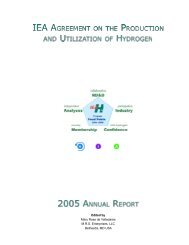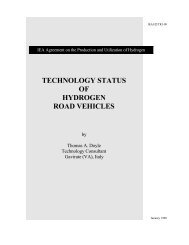ANNEx SoLId oxIdE FUEL CELLS - Hydrogen Implementing ...
ANNEx SoLId oxIdE FUEL CELLS - Hydrogen Implementing ...
ANNEx SoLId oxIdE FUEL CELLS - Hydrogen Implementing ...
Erfolgreiche ePaper selbst erstellen
Machen Sie aus Ihren PDF Publikationen ein blätterbares Flipbook mit unserer einzigartigen Google optimierten e-Paper Software.
Brennstoffzellen<br />
Laufende und im Berichtsjahr abgeschlossene Projekte<br />
(* IEA-Klassifikation)<br />
• 2R-CELL<br />
– A RELIABLE ANodE SUPPoRTEd THIN ELECTRoLyTE SoFC CELL RESISTANT To MUL-<br />
TIPLE THERMAL ANd REdox-CyCLES<br />
Lead: Fiaxell Sarl Funding: BFE<br />
Contact: Ihringer Raphël raphael.ihringer@fiaxell.com Period: 2009–2010<br />
8 Recherche énergétique 2010 – Rapports de synthèse<br />
R+D 5.2.1*<br />
Abstract: Because of their high power density in a wide range of temperature, anode supported thin film electrolytes are nowadays the mostly<br />
used cells in the SOFC area. Unfortunately, the latter suffer from an important problem that remained unsolved till today: they are<br />
totally destroyed when re-oxidation occurs in the anode chamber. This happens, for instance when fuel supply inappropriately stops.<br />
Cell peripheral re-oxidation is another well known figure where failures are initiated.<br />
• ACCELENT – ACCELERATEd TESTING oF SoFC CoMPoNENTS R+D 5.2.1<br />
Lead: Hexis AG Funding: BFE / HyCo-ERA-NET<br />
Contact: Andreas Mai andreas.mai@hexis.com Period: 2008–2011<br />
Abstract: Festoxid-Brennstoffzellen (Solid Oxide Fuel Cells, SOFC) sind ein typischer Bernnstoffzellen-Typus für stationäre Anwendungen. Als<br />
solche müssen sie Lebensdauern von 40.000 Std. und mehr erfüllen. In diesem Bereich ist es unmöglich, Prüfungen auf garantierte<br />
Lebensdauern im Labor durchzuführen. Stattdessen müssen Methoden gefunden werden, die Alterung der SOFC Komponenten so<br />
zu beeinflussen, dass ihre Haltbarkeit aus Tests mit ‚vernünftiger’ Dauer abgeleitet werden kann.<br />
• ASSENT – ANodE SUB-SySTEM dEvELoPMENT & oPTIMISATIoN FoR SoFC SySTEMS R+D 5.2.1<br />
Lead: Htcearmix Funding: EU-JU FCH<br />
Contact: Olivier Bucheli olivier.bucheli@htceramix.ch Period: 2010–2013<br />
Abstract: The high temperature fuel cell technologies have potential for high electrical efficiency, 45-60%, and total efficiency up to 95%.<br />
SOFC has the added benefit of offering commercial applications from 1 kW residential to several MW stationary units with high fuel<br />
flexibility. Whilst much effort is devoted to cell and stack issues, less attention has been paid to the components and sub-systems<br />
required for an operational system (www.fch-ju.eu/sites/default/files/assent[1].pdf).<br />
• ASTERIx3<br />
– ASSESSMENT oF SoFC CHP SySTEMS BUILd oN THE TECHNoLoGy oF HTCERA-<br />
MIx 3<br />
Lead: Htcearmix Funding: EU-FP7<br />
Contact: Olivier Bucheli olivier.bucheli@htceramix.ch Period: 2011–2012<br />
R+D 5.2.1<br />
Abstract: The objective of the collaboration was to evaluate HTceramix's SOFC technology in perspective of development of a residential micro-<br />
CHP application with a strong and well defined market focus. The project has achieved its goals in providing a serious evaluation of<br />
the feasibility of fuel cell based micro CHP. The viability of the technology has been validated and a proof of concept, for most aspects<br />
of the system, has been developed and tested.<br />
• LoTUS – LoW TEMPERATURE <strong>SoLId</strong> <strong>oxIdE</strong> <strong>FUEL</strong> <strong>CELLS</strong> FoR MICRo-CHP APPLICATIoNS R+D 5.2.1<br />
Lead: Htcearmix / SOFCPower Funding: EU-JU FCH<br />
Contact: Olivier Bucheli olivier.bucheli@htceramix.ch Period: 2009–2012<br />
Abstract: The objective of the LOTUS project is to build and test a Low Temperature SOFC system prototype based on new SOFC technology<br />
combined with low cost, mass-produced, proven components. The use of a modular concept and design practices from the heating<br />
appliances industry will reduce maintenance and repair downtime and costs of the system.<br />
• ModELING<br />
oF ENERGy CoNvERSIoN PRoCESSES AT THE MICRoSCALE R+D 5.2.1<br />
Lead: PSI Paul Scherrer Institut Funding: BFE<br />
Contact: Ioannis Mantzaras ioannis.mantzaras@psi.ch Period: 2009–2012<br />
Abstract: The aim of the project is to develop an advanced numerical tool capable of modeling key microscale processes occurring in both<br />
thermochemical and electrochemical conversion systems. A particular objective is to apply this model in a Polymer Electolyte Fuel<br />
Cell (PEMC) and compare the predictions with measurements of permeabilities and diffusivities inside the gas diffusion layer (GDL).<br />
• ModvAL<br />
7 – 7TH SyMPoSIUM oN <strong>FUEL</strong> CELL ModELING<br />
ANd ExPERIMENTAL vALIdATIoN<br />
Lead: EPFL Funding: BFE<br />
Contact: Jan van Herle jan.vanherle@epfl.ch Period: 2010<br />
R+D 5.2.1<br />
Abstract: The 2-day symposium is the 7th of an established annual event, initiated in 2004 by the Swiss Federal Energy Office. Taking place<br />
yearly in March, it alternates locations between Switzerland and Germany, and is hosted by a local academic institution. Focus of the<br />
venue is to present advances in modeling on mainly SOFC and PEFC, as well as experimental work for model validation. Attendance<br />
is 50 to 100 participants, from both academia and industry, many Europe, but increasingly from other continents as well.













